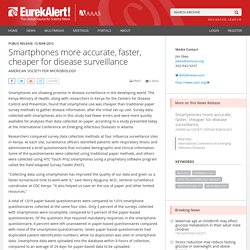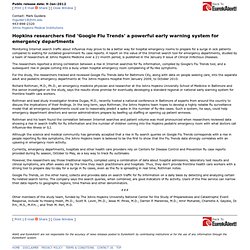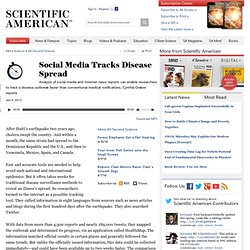

Is data mining for disease tracking good for public health or just another snooper's charter? Data mining has made many of us worry about who's looking at our Web searches and social media posts. But tracking health-related online activity could save lives. Question is: do we want it? We've heard it said often before: technology has the potential to turn our mobile devices into lifesaving tools. Flu Trends. Skip to content Thank you for stopping by.

Google Flu Trends and Google Dengue Trends are no longer publishing current estimates of Flu and Dengue fever based on search patterns. The historic estimates produced by Google Flu Trends and Google Dengue Trends are available below. When Google got flu wrong. JOHN ANGELILLO/UPI/Newscom The latest US influenza season is more severe and has caused more deaths than usual.

When influenza hit early and hard in the United States this year, it quietly claimed an unacknowledged victim: one of the cutting-edge techniques being used to monitor the outbreak. Dengue Trends. Smartphones more accurate, faster, cheaper for disease surveillance. Smartphones are showing promise in disease surveillance in the developing world.

The Kenya Ministry of Health, along with researchers in Kenya for the Centers for Disease Control and Prevention, found that smartphone use was cheaper than traditional paper survey methods to gather disease information, after the initial set-up cost. Survey data collected with smartphones also in this study had fewer errors and were more quickly available for analyses than data collected on paper, according to a study presented today at the International Conference on Emerging Infectious Diseases in Atlanta.
Researchers compared survey data collection methods at four influenza surveillance sites in Kenya. Flu Near You. Meaningful Use - Syndromic Surveillance. Introduction Syndromic Surveillance is "the systematic process of data collection and analysis for the purposes of detecting and characterizing outbreaks of disease in humans and animals in a timely manner" (RODS).

Rather than relying strictly on confirmed reports of disease or condition occurrence, syndromic surveillance attempts to bring together a variety of data - largely from the clinical setting, but from other sources in the community as well - to support decision making in the event of a disaster or emergency. The Health Effects of Social Networking. Here’s the list of terms the government uses to monitor Twitter for disease outbreaks. Sep 25, 2012 Earlier this year, the Department of Homeland Security released a list of keywords it tracks on social media websites.

The list, part of a DHS operations manual, includes a lot you’d expect: “al Qaeda,” “shots fired” and hundreds of other terms related to terrorism, domestic security and natural disasters. What a lot of people don’t know is that like DHS, the Department of Health and Human Services also has an interest in monitoring social media and its own list of keywords it monitors on Twitter.
It uses the list to look for signs of disease outbreaks. Unlike DHS, this list didn’t take FOIA and a Congressional hearing to be released. Twitter App Tracks Illness Outbreaks - Healthcare - Clinical Information Systems. MappyHealth - A #NowTrending2012 Entry - Following disease trends, 140 characters at a time. Www.nowtrendingchallenge.com/wp-content/uploads/2012/03/now_trending_challenge_illness_term_taxonomy.pdf. Using Twitter to track the flu: A better way to screen the Tweets. Public release date: 28-Jan-2013 [ Print | E-mail Share ] [ Close Window ] Contact: Phil Sneidermanprs@jhu.edu 443-287-9960Johns Hopkins University Sifting through social media messages has become a popular way to track when and where flu cases occur, but a key hurdle hampers the process: how to identify flu-infection tweets.

Some tweets are posted by people who have been sick with the virus, while others come from folks who are merely talking about the illness. If you are tracking actual flu cases, such conversations about the flu in general can skew the results. Triple-S – the syndromic surveillance project. Real-time Syndromic Surveillance. Latest Syndromic Surveillance Summary - 10 April 2014 PHE Syndromic Surveillance Summary 2014 week 14 (PDF, 214 KB) Latest Syndromic Surveillance Bulletins - 10 April 2014 PHE Remote Health Advice Weekly Bulletin 2014 Week 14 (PDF, 179 KB) PHE GP In Hours Weekly Bulletin 2014 Week 14 (PDF, 353 KB) PHE GP In Hours Weekly Data 2014 Week 14 (Excel Spreadsheet, 192 KB) PHE GP Out of Hours Weekly Bulletin 2014 Week 14 (PDF, 479 KB) RCGP Communicable and Respiratory Disease Report 2014 Week 14 (PDF, 397 KB) Latest Real-time Syndromic Surveillance Team Publications Morbey RA, Elliot AJ, Charlett A, Andrews N, Verlander NQ, Ibbotson S, Smith GE.

Elliot AJ, Hughes HE, Hughes TC, Locker TE, Brown R, Sarran C, Clewlow Y, Murray V, Bone A, Catchpole M, McCloskey B, Smith GE. Olympics-London looks to get ahead of disease threat. By Kate Kelland, Health and Science Correspondent LONDON, May 30 (Reuters) - If someone's stomach is churning and cramping after eating a burger or club sandwich from a pop-up vendor at the London Olympics, Brian McCloskey plans to be among the first to hear about it.

As the man in charge of disease surveillance during the Games, he says the greatest risk will be food poisoning from people eating street snacks in warm weather, failing to wash their hands and using the same toilets as millions of others. But he has a strategy to get ahead of the threat. McCloskey's Health Protection Agency Olympic co-ordination centre (OCC) will gather data on a daily basis - not only on confirmed cases of diseases such as measles, meningitis, salmonella and flu, but also on the stomach cramps, coughs, headaches and fever symptoms people complain of when they go to walk-in clinics or emergency rooms. "The main thing is to know what's happening," he adds. Sickweather. Who is sick? Track the Spread of Sickness and Disease at GermTrax. Hopkins researchers find 'Google Flu Trends' a powerful early warning system for emergency departments.
Public release date: 9-Jan-2012 [ Print | E-mail Share ] [ Close Window ] Contact: Mark Guideramguider1@jhmi.edu 443-898-2320Johns Hopkins Medical Institutions Monitoring Internet search traffic about influenza may prove to be a better way for hospital emergency rooms to prepare for a surge in sick patients compared to waiting for outdated government flu case reports.

A report on the value of the Internet search tool for emergency departments, studied by a team of researchers at Johns Hopkins Medicine over a 21-month period, is published in the January 9 issue of Clinical Infectious Diseases. Social Media Tracks Disease Spread: Scientific American Podcast. After Haiti’s earthquake two years ago, cholera swept the country.

And within a month, the same strain had spread to the Dominican Republic and the U.S., and then to Venezuela, Mexico, Spain, and Canada. Fast and accurate tools are needed to help avoid such national and international epidemics. New study: Cholera in Haiti tracked more rapidly by social media than traditional methods. Feasibility study of geospatial mapping of chronic disease risk to inform public health commissioning. Abstract Objective To explore the feasibility of producing small-area geospatial maps of chronic disease risk for use by clinical commissioning groups and public health teams. Study design Cross-sectional geospatial analysis using routinely collected general practitioner electronic record data. Online tools will help monitor potential disease outbreaks at the Olympics. Specifically, the authors pointed to the Global Public Health Intelligence Network and HealthMap as tools that could rise to such a challenge, at least on the disease surveillance side.
They also mentioned Bio.Diaspora--a tool that tracks global air travel patterns to predict the spreading of infectious diseases--as technology relevant to such a cause, according to an article in Medical News Today. Lead researcher Kamran Khan, of St. Michael's Hospital in Toronto, and his colleagues used similar methods to perform an analysis of the 2010 Winter Olympic Games in Vancouver. By narrowing down that most visitors to Vancouver via air travel originated from 25 cities, they were able to center their real-time threat monitoring efforts. Such efforts will be used for actual risk assessment at the 2012 Summer Olympic Games in London. Crowdsourcing, citizen sensing and Sensor Web technologies for public and environmental health surveillance and crisis management: trends, OGC standards and application examples.
Disease Sleuths Surf For Outbreaks Online. Most folks who wake up feeling crummy will sit down with a computer or smartphone before they sit down with a doctor. They might search the Web for remedies or tweet about their symptoms. And that's why scientists who track disease are turning to the Internet for early warning signs of epidemics.